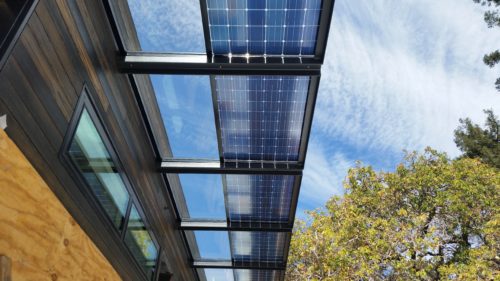Bifacial module
Bifacial Module
Bifacial modules produce solar power from both sides of the panel. Whereas traditional opaque-backsheeted panels are monofacial, bifacial modules expose both the front and backside of the solar cells. When bifacial modules are installed on a highly reflective surface (like a white TPO roof or on the ground with light-colored stones), some bifacial module manufacturers claim up to a 30% increase in production just from the extra power generated from the rear.

A bifacial solar module is a type of solar panel that can capture sunlight from both its front and rear sides. Unlike traditional monofacial panels that only absorb light from the top, bifacial panels use transparent or semi-transparent backsheets or dual glass to allow reflected light from the ground or nearby surfaces to also generate electricity.
Higher Energy Output
-
Can produce 5% to 30% more energy than monofacial panels depending on installation and surroundings.
-
Ideal for high-albedo surfaces (e.g., white roofs, sand, snow, or concrete).
Durable Build
-
Often made with glass-glass construction, making them more durable and resistant to environmental damage like UV, moisture, and corrosion.
Improved Performance Over Time
-
Lower degradation rate than conventional panels.
Bifacial solar modules are photovoltaic panels that can generate electricity from both the front and rear sides. Here are the key advantages and benefits of using bifacial modules:
Advantages and Benefits of Bifacial Solar Modules
1. Higher Energy Yield
-
Bifacial modules can produce up to 10–30% more energy compared to monofacial panels by capturing sunlight reflected from the ground (albedo effect).
-
Especially effective on highly reflective surfaces like white roofs, sand, snow, or light-colored gravel.
2. Lower Levelized Cost of Electricity (LCOE)
-
Despite slightly higher upfront costs, the higher output reduces the overall cost per kWh over time, improving return on investment.
3. Durability
-
Most bifacial modules are frameless and glass-glass, which enhances mechanical strength and resistance to UV, moisture, and corrosion.
4. Better Performance in Low Light
-
These modules perform well in diffuse and scattered light conditions, such as cloudy days or partial shading.
5. Longer Lifespan
-
The glass-glass structure often leads to less degradation and longer warranties, typically up to 30 years.
6. Reduced Hot Spot Risk
-
The design and materials help distribute heat more evenly, reducing the risk of hot spots that can damage traditional modules.
7. Flexible Installation Options
-
Suitable for various setups like ground-mount, tracking systems, floating solar, and vertical installations (e.g., for noise barriers or fences)